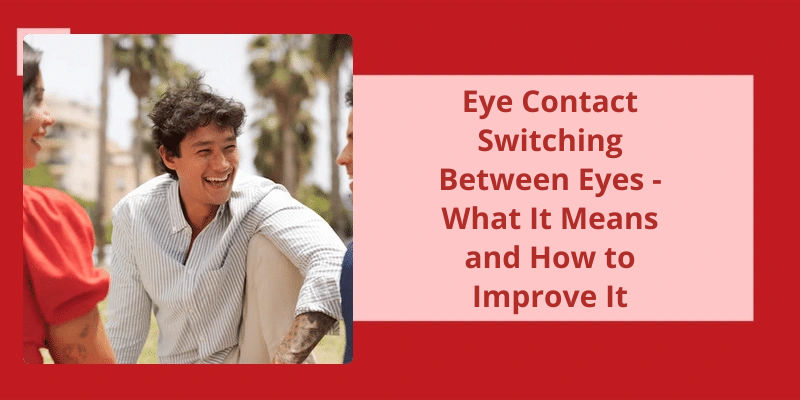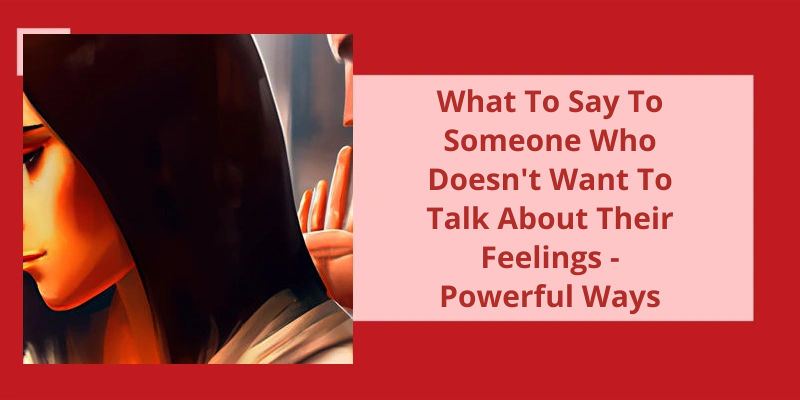Eye contact switching between eyes is a fascinating and complex interpersonal communication skill that involves the ability to alternate the direction of one's gaze between a person's left and right eye. This behavior may seem simple on the surface, but it actually represents a sophisticated cognitive and social process that can reveal a lot about a person's thoughts, emotions, and intentions. Eye contact switching plays a crucial role in various aspects of our lives, from building trust and rapport in social interactions to conveying power and dominance in business negotiations.
How Do You Switch Between Eyes During Eye Contact?
Maintain eye contact briefly before switching eyes – it’s important to hold eye contact for a few seconds before moving on to the other eye. This shows that you’re interested in the conversation and that you’re actively listening. By holding the eye contact for a few seconds, you’re also acknowledging the other persons presence and making them feel heard.
Keep your body relaxed and avoid fidgeting or looking away. Moving your head slightly when switching eyes can also help to keep the conversation flowing smoothly and naturally.
During conversations with friends or family members, try practicing switching between eyes while maintaining a natural and relaxed body language.
Avoid staring – while maintaining eye contact is important, staring can come across as creepy or aggressive. It’s important to strike a balance between maintaining eye contact and giving the other person space. If you feel uncomfortable or unsure, it’s okay to break eye contact briefly or look away.
By maintaining eye contact briefly before switching eyes, being aware of body language, and practicing in low-pressure situations, you can master this important social skill. Remember to be natural, relaxed, and respectful, and to consider the context of the conversation. With these tips in mind, youll be able to make genuine connections and have meaningful conversations with ease.
Interpersonal communication is a complex process that involves both verbal and nonverbal cues. One of the most important nonverbal cues is eye contact, which can convey various meanings depending on it’s intensity, duration, and frequency. Intermittent eye contact, in particular, is a common pattern of eye behavior that can indicate interest, engagement, or discomfort in social interactions. As such, understanding the nuances of eye contact is crucial for effective communication and relationship-building.
What Does Intermittent Eye Contact Mean?
Intermittent eye contact can mean a variety of things depending on the context and the situation. This type of eye contact can be seen as a sign of discomfort or anxiety, as the individual might be trying to avoid direct eye contact in order to lessen the intensity of the interaction. It can also be an indication of shyness or insecurity, as the individual might feel vulnerable or exposed by direct eye contact and choose to limit it accordingly.
For example, if someone is repeatedly making brief eye contact and then looking away, it might indicate that they’re feeling distracted or disengaged from the conversation.
While it can be tempting to jump to conclusions based on a single gesture or behavior, it’s important to consider all of the factors at play in order to get a more accurate read on what someone is communicating through their eye contact (or lack thereof). By taking the time to observe and interpret these signals, we can become more effective communicators and develop stronger connections with those around us.
The Cultural Differences in Eye Contact and What They Mean.
This topic discusses how eye contact varies across cultures and how it conveys different meanings depending on the cultural context.
The ability to make strong eye contact is an essential skill in many social situations, whether for personal or professional reasons. However, making eye contact for too long or too little can be awkward, so it’s important to find a balance. One popular rule is the 4-second rule, where holding gaze for four to five seconds at a time is considered ideal. But there’s more to it than just staring deeply into someone’s eyes. Here’s what you need to know about the 4-second rule for eye contact.
What Is the 4 Second Rule for Eye Contact?
The 4 second rule for eye contact refers to the practice of holding ones gaze on another persons eyes for a specific period of time before breaking it. Although it may sound simple, this practice can be a powerful tool in establishing rapport and building trust with others. The idea is to communicate confidence and interest through consistent eye contact, which in turn helps to establish credibility and establish a strong connection.
Rather, it’s a guideline that can be adjusted based on the context of the conversation and the relationship between individuals. In professional or formal settings, it may be more appropriate to stick to the 4 to 5 second guideline.
By practicing this technique consistently, individuals can improve their communication skills and enhance their interpersonal relationships in a variety of contexts. Whether in personal or professional settings, the ability to establish strong connections with others can be a valuable asset that can lead to greater success and fulfillment in life.
The Psychology Behind Eye Contact and It’s Impact on Communication
- Eye contact is a fundamental component of human communication.
- Studies have shown that eye contact can increase trust and convey confidence.
- Eye contact can also be used as a tool for persuasion and influence.
- However, too much or too little eye contact can have negative effects and convey discomfort or dishonesty.
- Cultural differences also play a role in the interpretation of eye contact and it’s impact on communication.
Now that we know the proper duration for maintaining eye contact, it’s important to understand the nuances of eye contact in different situations. Whether it’s in a professional setting, social gathering, or romantic encounter, the rules for appropriate eye contact can vary. Let’s explore them further.
What Are the Rules for Eye Contact?
After that, you can look away briefly to avoid intense staring. Also, keep in mind that different cultures have varying social norms when it comes to eye contact. In some cultures, maintaining prolonged eye contact is perceived as disrespectful or aggressive, while in others it’s considered a sign of attentiveness and honesty. Therefore, it’s always important to keep cultural differences in mind and adjust your eye contact accordingly.
When it comes to professional settings, eye contact can be crucial for building trust and establishing rapport with colleagues and clients. It can also convey confidence and assertiveness, which are important qualities in leadership roles. However, it’s important to be mindful of the situation and avoid making the other person feel uncomfortable or violated.
By following these simple rules and being attuned to the social context, you can use eye contact to build meaningful connections with others and convey confidence and respect.
How Can Someone Improve Their Eye Contact Skills and Build More Confidence?
One effective way to improve your eye contact skills and boost confidence is to practice maintaining eye contact with others during conversations. This can be done by consciously focusing on the other person’s eyes and avoiding distractions. Additionally, practicing active listening techniques such as nodding and asking follow-up questions can also help improve your confidence in social interactions.
Source: Eye contact: Don’t make these mistakes – MSU Extension
However, the meaning behind intense eye contact can vary depending on the situation and the individuals involved. It’s important to take into consideration the context and the person’s body language to interpret the true intention behind their gaze.
What Does It Mean When You Make Intense Eye Contact With Someone?
When we make intense eye contact with someone, it can signal a variety of things. Depending on the context and the individuals personality, it can be a means of asserting dominance in a conversation, or an attempt to influence the other persons perception. It can also be a way to communicate romantic feelings or to flirt subtly while maintaining some level of plausible deniability. This might explain why so many people use eye contact as a tool for seduction or to convey their interest in someone.
Of course, it’s worth noting that eye contact can also be a sign of trust and genuine connection with another person. When we look each other in the eyes, we’re often expressing our vulnerability and openness. We’re letting someone else see us in a way that we might not allow others to see us, and this can be a powerful way to bond with another human being.
However, it’s also important to pay attention to other cues and body language when we’re interpreting someones eye contact. Often, it’s not just a matter of how long someone looks at us, but also the way they hold their body, the way they speak, and the subtext of what they’re saying. All of these factors can give us clues as to what the person is really thinking and feeling, and help us to navigate the complexities of human interaction.
Ultimately, the meaning of intense eye contact will depend on the context and the individual in question. There’s no one-size-fits-all answer to this question, and we must be cautious about making assumptions or jumping to conclusions based on a single interaction. However, by being mindful of our own nonverbal cues and paying attention to the cues of others, we can develop a greater empathy and understanding of those around us, and perhaps even deepen our connections with them in meaningful ways.
The Cultural Differences in Eye Contact: How Eye Contact Is Perceived and Used Differently Across Cultures and Regions.
- In some cultures, direct eye contact is a sign of respect and attentiveness.
- Other cultures view direct eye contact as aggressive or confrontational.
- Some cultures may show deference by avoiding direct eye contact.
- In some regions, avoiding eye contact with authority figures is a sign of respect.
- Eye contact may be used to signal interest or attraction in some cultures.
- In other cultures, prolonged eye contact may be considered impolite or intrusive.
Avoiding eye contact during a conversation can be perceived in various ways, but there’s often a common underlying reason for this behavior. In this article, we will explore the significance of eye contact and why some people choose not to make it.
What Does It Mean When Someone Doesn T Look You in the Eye When They Talk to You?
One reason why people avoid eye contact is because they may be feeling shy or nervous.
It’s believed that avoiding eye contact is a common deception tactic as it makes the liar feel less guilty or ashamed. They may be trying to avoid being caught in a lie, or they may not want to reveal their true intentions, so they choose to avoid eye contact.
In such cases, avoiding eye contact may be a symptom of a larger underlying issue that requires professional help.
Lastly, some people may avoid eye contact as a result of being on the autism spectrum. They may find it difficult to interpret facial expressions and body language, and as such, eye contact is too much for them to handle.
It’s crucial to pay attention and be aware of other verbal and non-verbal cues to decipher what someone may be trying to communicate.
The Cultural Significance of Eye Contact in Different Parts of the World
- In some cultures, eye contact is a sign of confidence and respect.
- In other cultures, avoiding eye contact is a sign of respect and humility.
- In Japan, eye contact is important but too much eye contact is considered aggressive.
- In some Native American cultures, prolonged eye contact is a sign of trust and sincerity.
- In Middle Eastern cultures, prolonged eye contact between opposite genders is often avoided.
Conclusion
In conclusion, eye contact is an essential aspect of human communication that reflects our emotions, thoughts, and intentions. It’s a powerful technique that can help establish trust, build rapport, and convey authority. It can evoke various emotions and intensify the overall impact of a communication.






